6 Tips For Making A Small Paved Yard Attractive For Bees And Pollinators
It’s quite
common for homes to have only a small, paved yard
for a garden, especially in cities. Likewise, those who live in apartments may have only a balcony or similar. However, there are a number of steps you can take to make a small yard or balcony attractive for bees and pollinators.
If you are looking for ideas, my response to the query below may help you.
How can I attract bees to my paved yard or balcony?
Hi
I have just moved into a terrace house with a walled concrete yard out the back. No soil, and no plans currently to alter that.
I get reasonable sunshine in most of the yard, but the fencing creates shade around the perimeters. I have little space and need to add a garden shed for storage. I’m guessing I'll be limited to planters.
Would appreciate your advice if you have any. I'm wanting to make plans but a little stuck for ideas.
Julia, UK
6 Tips –
Making A Small Paved Yard Or Balcony Attractive For Bees And Pollinators
1. Make use of containers
In a fully paved or concreted yard or on a balcony, it will be necessary to make use of containers, which can include:
- planters,
- hanging baskets,
- window
boxes.
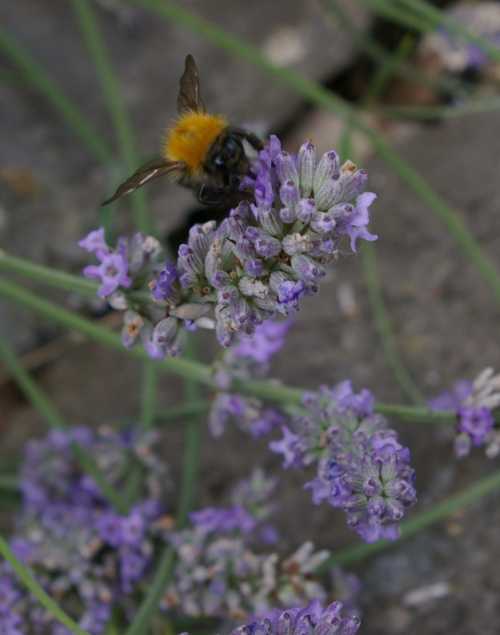 Lavender can be grown in pots and may be visited by bees.
Lavender can be grown in pots and may be visited by bees.
If watering the containers could present a problem, look out for flowering plants that will tolerate dry conditions. To bring the bees into your garden, you could try these in your containers:
2. Grow plants on the wall
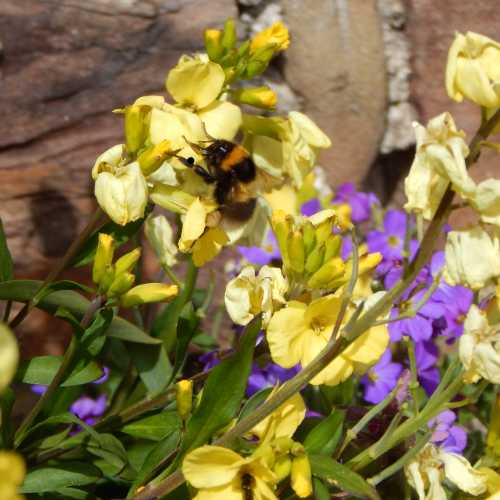 Yellow wallflower and purple aubretia growing on a wall - and a visiting bumble bee.
Yellow wallflower and purple aubretia growing on a wall - and a visiting bumble bee.
If you have nooks and crannies in a wall around your yard, you could experiment with rockery plants that will grow happily in such locations.
- Wallflower
- Aubretia
- Valerian
- Yellow Coryadalis
- Sempervivums
- Ivy-leaved toadflax
- Campanula (bell flower)
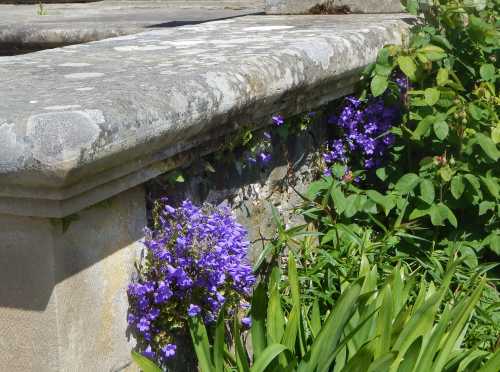 Clumps of campanula look lovely growing in a wall.
Clumps of campanula look lovely growing in a wall.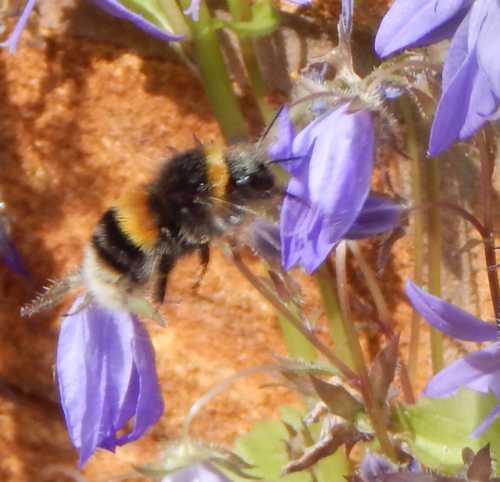 Campanula is popular with bees.
Campanula is popular with bees.
3. Include climbers
If you have a wall or similar support structure such as a garden shed in a back yard, it may be feasible to grow climbing plants. Grow them in planters positioned directly against trellis mounted to the wall.
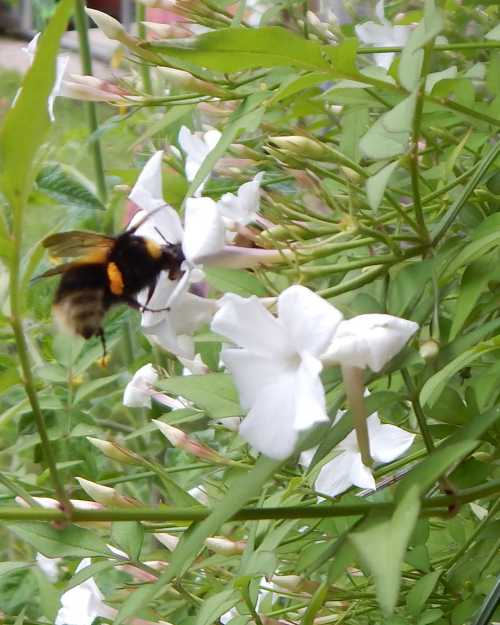 Jasmine is beautifully fragrant and popular with bees.
Jasmine is beautifully fragrant and popular with bees.Remember to consider general maintenance. Climbers may need to withstand pruning or repotting from time to time to allow work to be undertaken, unless you don't mind replacing plants.
Your could consider:
- Jasmine
- Honeysuckle
- Passionflower
- Wisteria
- Climbing varieties of pyracantha
- Dog rose.
With careful planning, you may even be able to erect a decorative arch in the yard, against which flowering climbers can be grown, but this will depend on how the space is used.
For a balcony, it may be more appropriate to add upright supports to containers, such as obelisks for climbing plants in pots. These plants are great in an obelisk or upright support and bees love them:
- Sweetpeas
- Morning glory
- Runner beans - which have the added advantage of providing a food crop later.
4. Use trailing and cascading plants
Hanging baskets and window boxes are obvious candidates for trailing plants and cascading plants, but there are other options.
For instance, you could experiment with raised pots on legs - these can add additional interest to a small yard because of the opportunity to add height.
Trailing/cascading plants for bees could include the following:
- Aubretia
- Trailing varieties of sweet pea, campanula, cranesbill geranium,
- Calibrachoa
5. Choose flowering plants with an 'upright' growth habit and many florets
You can maximise space by making use of plants that have a more upright growing habit with many flowers up the stems, rather than bushy, sprawling specimens with a single flowerhead on each stem.
Here are a few examples, but remember to check the required growing conditions and care:
- Lamb's ear,
- Lupine,
- Salvias,
- verbascums,
- Mallows,
- veronicas,
- Spider flower,
- Delphinium.
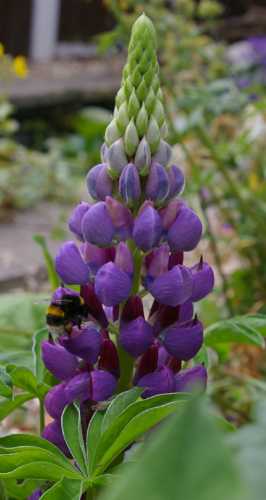 To maximise a small amount of space, choose plants with upright stems and many florets on each stem, such as Lupine (Lupin).
To maximise a small amount of space, choose plants with upright stems and many florets on each stem, such as Lupine (Lupin).
6. Use of outdoor buildings
Some small, older properties have a yard with a small stone storage building in place.
On the other hand if you have
a shed in your yard or need to build one, try to site it in the area least valuable for
plants, such as a very shady corner, so that key planting space is not wasted.
If the height of the shed means the structure
has sunlight, you could investigate options for a green roof planted with herbs
or flowering succulents, wild flowers or clover. Hanging baskets and carefully positioned containers
might also be attached to a shed.
A sunny side of the shed could have a climbing plant in a container. If you will periodically need to weatherproof the shed (if it’s made of wood) be sure to choose a plant that will tolerate a good pruning to allow you to undertake the work periodically.
More articles about bees and plants
- Bees Foraging On Eryngium (Sea Holly) Eryngium: A magnet for bumble bees, honey bees and various solitary species. It is fairly hardy.
- Bees & Poppies Bees love foraging on poppies for pollen - especially the Opium Poppy - Papaver somniferum
- Pulmonaria Officinalis - A Wonderful Early Flowering Plant For Bees Pulmonaria Officinalis attracts bumblebees and hairy footed flower bees and is easy to grow
- Bees love lupins – but so do slugs and snails, so what can you do? Bees love lupins – but so do slugs and snails, so what can you do? Here's a way to protect your lupins....using garlic!
- Bees And Bee Balm Bee Balm (Monarda) - also known as 'Bergamot) is a herbaceous perennial which is attractive for bees.
If you found this page helpful or interesting, I'd really be grateful if you would share it with others - if not this page, perhaps another, such as Gardening For Bees.
Thank you so much :) .